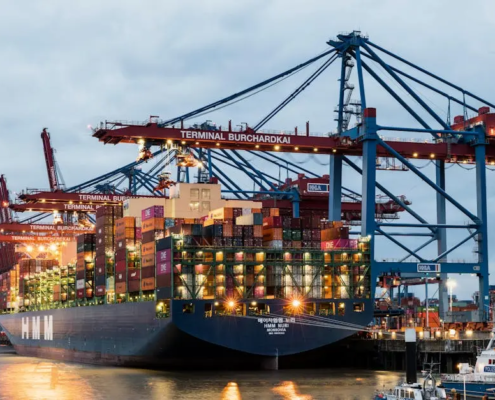Technology Trends Transforming Port Operations in 2025
As the maritime industry continues to evolve, ports around the globe are increasingly adopting cutting-edge technologies to enhance efficiency, safety, and sustainability. In 2025, several transformative technology trends are shaping the way ports operate, paving the way for smarter and more agile port operations. This blog post explores these trends, their implications, and how companies like Nicom Maritime are supporting the modernization of port operations.

Why Are Technology Trends Crucial for Port Operations?
Ports are vital nodes in the global supply chain, handling billions of tons of cargo every year. With growing demands for faster turnaround times, enhanced security, and reduced environmental impact, embracing technological innovations is no longer optional – it’s a necessity. These technologies not only optimize existing processes but also enable ports to stay competitive in a rapidly changing landscape.
Key Technology Trends Revolutionizing Ports in 2025
1. Digital Twins for Port Optimization
Digital twin technology creates virtual replicas of physical port environments, enabling real-time monitoring and simulation of port operations. By providing a comprehensive overview of operations, digital twins help ports:
- Predict and prevent potential disruptions.
- Optimize cargo handling and vessel scheduling.
- Reduce downtime and improve asset utilization.
Nicom Maritime’s Role: Our custom software development services integrate digital twin capabilities tailored to port needs, ensuring seamless data visualization and actionable insights.
2. Artificial Intelligence (AI) and Machine Learning (ML)
AI and ML are transforming decision-making in port operations by automating complex processes and uncovering patterns in large datasets. Applications include:
- Predictive maintenance for port equipment.
- Automated planning and allocation of resources.
- Enhanced security through intelligent threat detection.
Ports using AI-powered systems report significant reductions in vessel berthing times and improved cargo throughput.
3. Autonomous Vehicles and Drones
Automation is extending to vehicles and drones within port environments. Autonomous trucks and cranes are reducing human error, while drones are being used for:
- Conducting aerial inspections of port infrastructure.
- Monitoring environmental conditions.
- Facilitating inventory management in warehouses.
4. Blockchain for Secure and Transparent Transactions
Blockchain technology is revolutionizing maritime logistics by providing a secure and immutable ledger for transactions. Key benefits include:
- Enhanced traceability of cargo.
- Reduced paperwork and faster clearance processes.
- Improved trust among stakeholders through transparency.
5. Internet of Things (IoT) for Smarter Operations
IoT devices enable real-time tracking and monitoring of assets, cargo, and environmental conditions. Ports are using IoT to:
- Optimize container handling through connected sensors.
- Monitor equipment health to prevent breakdowns.
- Ensure compliance with environmental regulations.
6. Green Technologies for Sustainability
With increasing focus on sustainability, ports are adopting green technologies such as:
- Electrified and hybrid port equipment.
- Shore-to-ship power systems to reduce emissions.
- Renewable energy sources like solar and wind.
7. Cybersecurity for Enhanced Protection
As ports become more connected, the risk of cyberattacks increases. Advanced cybersecurity measures are essential to safeguarding sensitive information and critical infrastructure. These can include:
- AI-driven threat detection systems.
- Regular vulnerability assessments.
- Robust data encryption protocols.
Explore our cybersecurity solutions designed to protect critical port operations.
The Benefits of Embracing Technology in Ports
By leveraging these technologies, ports can achieve:
- Increased Efficiency: Faster cargo handling and reduced turnaround times.
- Enhanced Safety: Minimization of accidents and human errors.
- Cost Savings: Optimization of resources and predictive maintenance.
- Sustainability Goals: Reduced carbon footprint and compliance with environmental standards.
Challenges and Considerations
While these technologies offer immense potential, ports must also address challenges such as:
- Integration Costs: High upfront investments in infrastructure and training.
- Interoperability Issues: Ensuring different systems and devices work seamlessly together.
- Data Security Concerns: Protecting sensitive data from cyber threats.
Nicom Maritime’s Expertise: We help ports navigate these challenges by offering end-to-end digital transformation solutions, from initial consultation to implementation and support.
How Nicom Maritime Can Help
At Nicom Maritime, we specialize in empowering ports with innovative technology solutions. Our services include:
- Custom software development for port operations.
- Cybersecurity solutions to protect critical assets.
- Managed IT Services for compliance and efficient IT infrastructure management.
- Dashboard solutions that consolidate critical information into a single, intuitive interface.
- Revenue and expense tracking, dispatch and scheduling, and billing through off-the-shelf solutions already trusted by pilotages, ports, and waterways.
Internal Link: Explore our full range of port technology services.
Conclusion
The year 2025 marks a pivotal moment for port operations as emerging technologies redefine what’s possible. From digital twins and AI to green technologies and IoT, the future of ports is smarter, safer, and more sustainable. By embracing these trends, ports can unlock new levels of efficiency and competitiveness.
Ready to transform your port operations?
Contact Nicom Maritime today to discover how we can help you stay ahead in this dynamic industry and support your port’s digital transformation journey.


